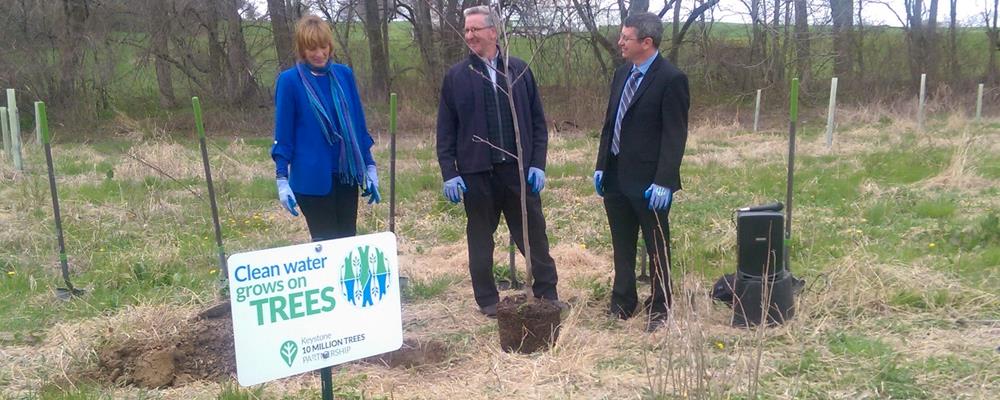Octoraro Native Pant Nursery donated the first 100 trees to the April 24 kickoff of a major effort to plant 10 million trees in Pennsylvania. The Keystone 10 Million Trees Partnership is being led by the Chesapeake Bay Foundation (CBF), the Pennsylvania Department of Conservation and Natural Resources (DCNR) and the Pennsylvania Department of Agriculture (PDA).
The Partnership is a collaborative effort of national, regional, state, and local agencies, conservation organizations, outdoors enthusiasts, businesses, and citizens committed to improving Pennsylvania’s communities, economy, and ecology.
“We are pleased that Octoraro was able to donate these 100 trees to help launch this exciting project,” said Jim MacKenzie, president of Octoraro Native Plant Nursery. “This is an ambitious effort to improve water quality in Pennsylvania’s rivers and streams. We commend CBF, DCNR and PDA for their vison and foresight in launching this program.
The Octoraro donated trees were a variety of native species. Octoraro specializes in growing mid-Atlantic native trees and shrubs from regional seed sources.
About 100 conservationists, including three state cabinet secretaries and the Region III Administrator of the Environmental Protection Agency (EPA), met on the Garber Farm in Manheim for the official launch of the Partnership and a tree-planting in a streamside buffer along Little Chiques Creek.
By the end of April 2018, the Keystone 10 Million Trees Partnership had already planted more than 31,000 trees at over 50 locations throughout Pennsylvania. The Partnership is a collaborative effort, coordinated by the CBF, national, regional, state, and local agencies, conservation organizations, watershed groups, conservancies, outdoors enthusiasts, businesses, and individuals. The goal is to plant 10 million trees by the end of 2025.
“The old proverb, “it takes a village,” is certainly true for restoring Pennsylvania’s rivers and streams,” said CBF President William C. Baker. “The Commonwealth is significantly behind in meeting its pollution-reduction commitments and the Keystone 10 Million Tree Partnership will accelerate efforts to close that gap.”
“When we look at solutions for some of our conservation challenges such as managing stormwater from very heavy rain events, having clean drinking water, and providing habitat for fish and wildlife, it turns out that trees are the answer,” DCNR Secretary Cindy Adams Dunn said. “We are excited to work with the Chesapeake Bay Foundation and many other partners on this movement to plant trees along streams and in communities across Pennsylvania.”
Roughly 19,000 miles of Pennsylvania’s rivers and streams are impaired by polluted runoff and the legacy of coal mining. Trees are the most cost-effective tools for cleaning and protecting waterways by filtering and absorbing polluted runoff, stabilizing streambanks, and improving soil quality.
The Commonwealth’s Clean Water Blueprint calls for about 95,000 acres of forested buffers to be planted in Pennsylvania’s portion of the Chesapeake Bay watershed. Adding 10 million new trees alongside streams, streets, and other priority landscapes would accelerate the Keystone State toward its clean water goals, achieving as much as two-thirds of the 95,000-acre goal.
“A farm is the perfect place to kick off this initiative,” Agriculture Secretary Russell Redding said. “Prosperous farms and a safe, abundant food supply depend on clean water, and a clean water supply depends on strategic farm management practices like forested buffers. Pennsylvania’s farmers are key to clean water for our region and we are pleased to support them as stewards of our resources.”
The Partnership is placing special emphasis on plantings in five counties in southcentral Pennsylvania because of large contributions of nitrogen, and that local stream impairment and overall loss of trees along streams and streets, is where greatest need meets greatest opportunity. The Partnership can jumpstart the Commonwealth’s efforts with concentrated plantings in those counties.
Trees placed in parks, municipal properties and other urban and suburban settings absorb and clean stormwater, reduce flooding, and help restore abandoned mine land.
“Trees, especially when alongside streams and streets, are one of the most cost-effective ways to restore and protect stream health, help keep nutrients and soils on the land, and cleanse drinking water sources,” said Harry Campbell, CBF Executive Director in Pennsylvania. “More trees benefit our farmers, our communities, and our health and welfare.”
Campbell expressed confidence in the Partnership’s effort and noted that its success will be influenced by how it evolves. “Many hands make light work. Together with partners new and old, we can plant 10 million trees,” he said. “We encourage organizations, business, schools, and anyone else concerned about restoring and protecting Pennsylvania’s waters, to sign up as partners. All that’s necessary is a commitment to reducing pollution and to planting trees as a solution to making that happen.”
Photo: Left to right: Secretary of Conservation and Natural Resources Cindy Dunn, Secretary of Agriculture Russell Redding and Secretary of Environmental Protection Patrick McDonnell



